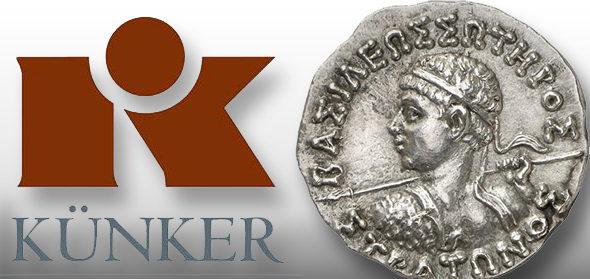
Over 6.700 lots with a total estimate of more than 6.5 million euros will be auctioned off by Künker in March. You will find German and world coins featuring multiple special collections. Phaleristic objects and ancient coins are particularly well represented this time.
It is, as always, a very special offer that Künker has assembled for its customers, to be auctioned off in the upcoming spring auction taking place from March 9 to 13, 2015. From ancient to modern times, from orders to minting tools, there is something for everyone in the four rare coin sale auction catalogs. Auction #259 comprises a large offer of phaleristic items, including probably the most important collection of Vatican orders and decorations that has ever been for sale at auction. Auction #260 offers not only world gold coins but Russian coins and medals as well as German coins after 1871. Auction #261 comes next, offering two special collections for sale: Schleswig-Holstein / Denmark and Saxe-Altenburg. Auction #262 is reserved for ancient coins and we need to mention a large and important collection of coins from the Roman Republic.
Auction 259: Orders and Decorations
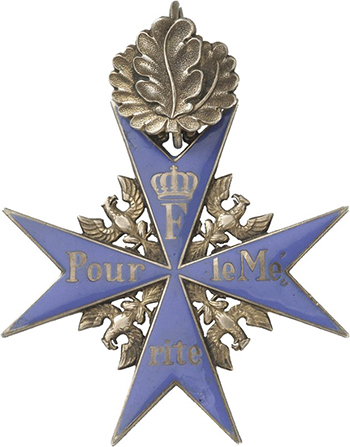 The 11th phaleristic auction catalog of Künker consists of about 800 lots. It starts with decorations of the German States, including series from Bavaria, Hanover, Hohenzollern, Oldenburg, Prussia and Saxony. You will find a number of important individual items, like the Bavarian Prinzregent Luitpold medal in gold (23, estimate: 3,000 euros), the Prussian Pour le mérite with oak leaves, awarded to Admiral Reinhard Scheer in 1916 (95, estimate: 10,000 euros) or a breast star in reduced size of the Order of the Rue Crown (130, estimate: 3,000 euros). Next in line are the decorations of the Weimar Republic, the German Empire and, notably, the German Democratic Republic. That is the heading under which the legacy of presumably the most decorated civilian of the country, Prof. Dr. Dr. h. c. Peter Adolf Thiessen, is offered for sale, containing decorations and documents that were published three years ago. At the heart of the section of European orders and decorations is a comprehensive collection of British order insignia. Apart from that, important series of Bulgaria, Denmark, France, Italy, Austria, Portugal, Rumania, Russia, Sweden and Spain are also available. In addition, probably the most important collection of orders and decorations of the Holy See of Dr. Norbert Herkner will be auctioned off. Let us single out one example only, the extremely rare military and civilian badge of honor bearing the portrait of Pope Pius IX (570, estimate: 15,000 euros).
The 11th phaleristic auction catalog of Künker consists of about 800 lots. It starts with decorations of the German States, including series from Bavaria, Hanover, Hohenzollern, Oldenburg, Prussia and Saxony. You will find a number of important individual items, like the Bavarian Prinzregent Luitpold medal in gold (23, estimate: 3,000 euros), the Prussian Pour le mérite with oak leaves, awarded to Admiral Reinhard Scheer in 1916 (95, estimate: 10,000 euros) or a breast star in reduced size of the Order of the Rue Crown (130, estimate: 3,000 euros). Next in line are the decorations of the Weimar Republic, the German Empire and, notably, the German Democratic Republic. That is the heading under which the legacy of presumably the most decorated civilian of the country, Prof. Dr. Dr. h. c. Peter Adolf Thiessen, is offered for sale, containing decorations and documents that were published three years ago. At the heart of the section of European orders and decorations is a comprehensive collection of British order insignia. Apart from that, important series of Bulgaria, Denmark, France, Italy, Austria, Portugal, Rumania, Russia, Sweden and Spain are also available. In addition, probably the most important collection of orders and decorations of the Holy See of Dr. Norbert Herkner will be auctioned off. Let us single out one example only, the extremely rare military and civilian badge of honor bearing the portrait of Pope Pius IX (570, estimate: 15,000 euros).
The oversea section offers interesting material as well: not only series from the Empire of Brazil, Japan and the Ottoman Empire will be sold but a number of order collars as well that are part of a legacy of a head of state whose identity, despite the most thorough research, could not have been determined for sure. These items include a collar in gold of the Mexican Order of the Aztec Eagle (757, estimate: 10,000 euros), an order set with collar of the Nepalese Order of Ojasvi Rajanya (758, estimate: 15,000 euros) and an order set for Dames in gold with diamonds and with collar of the Thai Order of the Royal House of Chakri (764, estimate: 15,000 euros).
The item with this auction sale’s highest pre-sale estimate can be found in the Turkish section. It is a gem of the 1st class with brilliants of the Order of Medjidjie.
Auction 260: Russia – Gold Coins – German Coins after 1871
Although the 413 Russian coins, to be auctioned off on Tuesday morning, include items with a higher estimate, the inconspicuous beard token of Peter the Great is highly likely to be the highlight within this sale. After all, better than any other coin this item represents the new policy of Peter the Great who had long beards cut short, in the literal sense of the word. Anyone who did not abide by his law on the European beard was forced to pay a tax. After his payment he then received a beard token as proof (1031, VF, estimate: 1,000 euros).
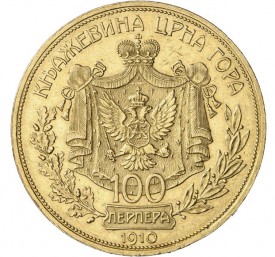 The gold coins of Europe and Germany are next. The many gorgeous specimens from the Late Middle Ages catch the eye, as the magnificent tourelle d’or of Joan of Brabant, 1383-1406 (1429, estimate: 15,000 euros), the chaise d’or of French King Philip VI, 1328-1350 (1453, EF, estimate: 7,500 euros) or the guyennois d’or of the English King Edward III, 1327-1362 (1534, EF, estimate: 3,000 euros). They all recall the time of the 100 Years’ War when France and Britain were beginning to become something like a nation.
The gold coins of Europe and Germany are next. The many gorgeous specimens from the Late Middle Ages catch the eye, as the magnificent tourelle d’or of Joan of Brabant, 1383-1406 (1429, estimate: 15,000 euros), the chaise d’or of French King Philip VI, 1328-1350 (1453, EF, estimate: 7,500 euros) or the guyennois d’or of the English King Edward III, 1327-1362 (1534, EF, estimate: 3,000 euros). They all recall the time of the 100 Years’ War when France and Britain were beginning to become something like a nation.
The sheer number of rarities, assortments and series makes it is impossible to mention them all. Thus, we restrict ourselves to an extremely rare double ducat of the Swiss city of Luzern from 1741, acting as representative of the entire range of the foreign countries here (1899, FDC, estimate: 30,000 euros) and, for Germany, a 7 ducat piece of the Dukes John Casimir and John Ernest of Saxe-Coburg-Eisenach, struck in Saalfeld in 1599. The latter is a unique specimen with a provenance that dates back quite some time: it was sold for the first time by Otto Helbing in 1924 (2527, VF, estimate: 20,000 euros).
The auction’s highlight is yet to come with Künker presenting a range of imperial coins in auction #260 that is nearly encountered in this completeness and quality. All the great rarities are there: Frederick the Wise (2747, about FDC, estimate: 60,000 euros), Baden 10 mark 1880 (2843, VF, estimate: 20,000 euros), Prussia 10 Mark 1878 B (3047, VF, estimate: 50,000 euros) and the rarest imperial gold type of all: Saxe-Coburg-Gotha, 20 mark 1872 (3141, about FDC, estimate: 60,000 euros).
Auction 261: Schleswig-Holstein and Denmark, Saxe-Altenburg as well as Coins and Medals from Medieval and Modern Times
His entire life, Kurt Zentini was interested in the coinage of Schleswig-Holstein, and Denmark as the historically so closely intertwined neighbors. His collection, comprising more than 400 lots, is now up for auction. This is a collection every collector dreams of, ranging from the ordinary pfennig, estimated at 25 euros, to the great rarity with an estimate in the five-digit range. The collection covers the early medieval denarii of the Danish Kings, until the ones of King Christian X (1912-1947), as well all the coinages in the name of the different principalities on the territory of modern-day Schleswig-Holstein, some of which used to be controlled by Denmark. This collection magnificently illustrates how complex the nexuses were in the Holy Roman Empire! As a representative of the great number of interesting items in this collection we will mention here only a very rare gold gulden of Duke Christian III, struck in Schleswig in 1536 following the model of the Rhenish gold gulden (4136, VF, estimate: 10,000 euros).
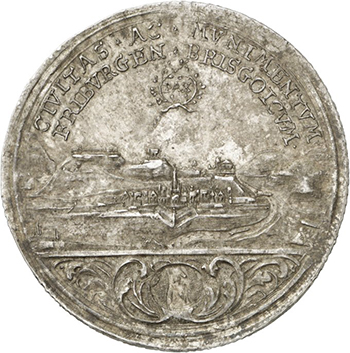 The Zentini Collection is followed by the collection of Konrad Bretschneider consisting of coins of the Duchy of Saxe-Altenburg. In 1603, after the death of Duke Frederick William I of Saxe-Weimar, this duchy was separated and taken over by his sons. Ranging from the gorgeous heavy gold coins dating from 1606 to the humble dreier, this collection comes up with many types struck between 1603 and the death of Frederick William III which terminated the elder line of Saxe-Altenburg in 1672. To single out just one example, there is the double ducat, struck in Saalfeld in 1610, with the dies of the ¼ reichtsthaler, of which only one other specimen is known to exist (4407, VF-EF, estimate: 5,000 euros).
The Zentini Collection is followed by the collection of Konrad Bretschneider consisting of coins of the Duchy of Saxe-Altenburg. In 1603, after the death of Duke Frederick William I of Saxe-Weimar, this duchy was separated and taken over by his sons. Ranging from the gorgeous heavy gold coins dating from 1606 to the humble dreier, this collection comes up with many types struck between 1603 and the death of Frederick William III which terminated the elder line of Saxe-Altenburg in 1672. To single out just one example, there is the double ducat, struck in Saalfeld in 1610, with the dies of the ¼ reichtsthaler, of which only one other specimen is known to exist (4407, VF-EF, estimate: 5,000 euros).
German and world coins and medals from medieval and modern times make up the big second part of catalog #261. We will mention just one item, an attractive mining thaler of the Archbishop of Cologne from 1759, made in Bonn or Coblenz from Westphalian fine silver. It was produced on the occasion of the mining at Ramsbeck being resumed and features an elaborate depiction of a mining scene (4886, EF, estimate: 20,000 euros).
As part of the world coins, we would like to highlight two spectacular items: a 30 tari piece that was struck during the French besieging Malta, dating from 1800 (5794, VF, estimate: 75,000 euros) and a pattern for a Chinese dollar from the year 3, which corresponds to 1911, according to our calendar. It is the very rare variety of the dragon with the long whiskers (5968, EF-FDC, estimate: 50,000 euros).
Auction 262: Ancient Coins
With that we have arrived at the ancient coins that come up with incredibly beautiful specimens this time. Caulonia, Naxos, Syracuse, Abdera, the Bisaltes and many more are the crème de la crème of Greek die cutting. Just think of the wonderful example of the coinage that Carthage has produced, with the help of Greek die cutters. In this sale we will find one of the famous tetradrachms featuring a delicately carved female head with the Phrygian cap on the obverse. This woman has been given many different names by scholars, for example Queen Dido of Carthage (7079, EF, estimate: 25,000 Euro). Other items should not go unmentioned either, like the extremely rare gold coinage of the Koinon of Macedonia from the 3rd cent. A. D. (7126, EF, estimate: 8,000 euros) and a number of coins made of electrum.
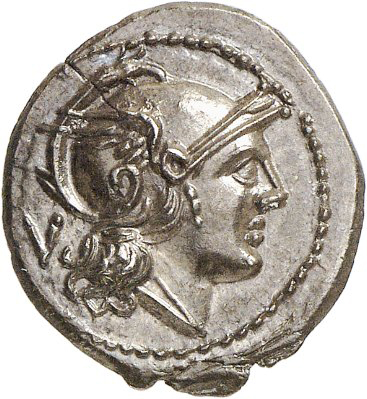 The unchallenged highlight of this auction, however, is the truly outstanding collection of coins from the Roman Republic. Many specimens offered for sale are hard to come by on the market, as a very early quinarius produced in a mint in the south-east of Italy (7392, Cr. 84/2, EF, estimate: 6,000 euros), a denarius of Atilius Nomentanus (7429, Cr. 225/1, EF, estimate: 2,000 euros), a denarius of Arrius Secundus bearing an unusual portrait of young Octavian (7748, Cr. 513/2, EF / about EF, estimate: 12,500 euros), a denarius of P. Licinius Crassus from 47/6 (7782, Cr. 460/2, VF / about EF, estimate: 2,000 euros) and a denarius of Publius Servilius Casca with Victoria walking over the broken scepter (7810, Cr. 507/2, EF, estimate: 10,000 euros).
The unchallenged highlight of this auction, however, is the truly outstanding collection of coins from the Roman Republic. Many specimens offered for sale are hard to come by on the market, as a very early quinarius produced in a mint in the south-east of Italy (7392, Cr. 84/2, EF, estimate: 6,000 euros), a denarius of Atilius Nomentanus (7429, Cr. 225/1, EF, estimate: 2,000 euros), a denarius of Arrius Secundus bearing an unusual portrait of young Octavian (7748, Cr. 513/2, EF / about EF, estimate: 12,500 euros), a denarius of P. Licinius Crassus from 47/6 (7782, Cr. 460/2, VF / about EF, estimate: 2,000 euros) and a denarius of Publius Servilius Casca with Victoria walking over the broken scepter (7810, Cr. 507/2, EF, estimate: 10,000 euros).
The highlight of this collection is, beyond doubt, the series of aurei, first of all the aureus of Sextus Pompey with the portrait of his father and his brother (7818, Cr. 511/1, VF+, estimate: 100,000 euros), an aureus bearing the portrait of Marc Antony from 40 B. C. (7828, Cr. 521/1, VF, estimate: 25,000 euros) and an aureus of Octavian from 43 B. C. with Cybele on its reverse (7878, Cr. 491/2, VF+, estimate: 10,000 euros).
All these rarities make you almost neglect the coins from imperial times. Yet they offer much spectacular and interesting material as well. Whether bronze, silver or gold – every collector will find appealing items at all price levels. At the very front, naturally, are the many perfectly preserved aurei, as the ones of Domitian (8007, ab. EF / EF, estimate: 20,000 euros), Marcus Aurelius (8100, ab. FDC, estimate: 30,000 Euro), Philip I (8259, ab. EF, estimate: 25,000 euros) and Postumus (8299, VF+ / EF, estimate: 20,000 euros).
A simple principle applies to this catalog, as to any other for that matter: only he who inspects the abundance of material carefully can spot the coin that has his name on it.
The auction sale catalogs can be requested at Künker, Nobbenburgerstraße 4a, D-49 076 Osnabrück; phone: +49 (0)541 / 96 20 20; fax: +49 (0)541 / 96 20 222; or email: [email protected]. All coins can be viewed online, four weeks prior to the auction, at https://www.kuenker.de/Unsere_Auctionen.Kuenker.
Did you know that you can buy direct from Künker GmbH? Check out their live store at MA-Shops.com




